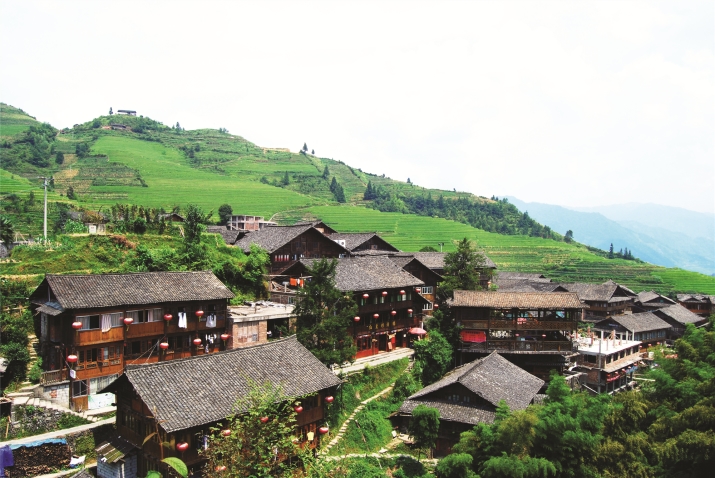|
||||||||||
| Home Nation World Business Opinion Lifestyle ChinAfrica Multimedia Columnists Documents Special Reports |
|
||||||||||
| Home Nation World Business Opinion Lifestyle ChinAfrica Multimedia Columnists Documents Special Reports |
| ChinAfrica |
| Growth in Spotlight |
| China's achievements over the past 70 years are a testament to its development commitment |
| By Xia Yuanyuan | VOL.11 October ·2019-09-30 |

China's rural areas have seen a steady improvement in income and living standards since the founding of the PRC (HELLORF)
October 1 marks the 70th anniversary of the founding of the People's Republic of China (PRC). During this period, tremendous changes have taken place in China's social development, economy, people's livelihood and international status.
China's transformation from a poor backward nation into a modern, prosperous one is an amazing achievement. Not only has the country narrowed its gap with developed countries and provided maximum benefits to citizens by tackling poverty challenges, but it has also actively participated in the international affairs and gained a positive reputation for its diplomacy.
To put its achievements into perspective, ChinAfrica breaks down the numbers behind China's development across a wide range of sectors.
Economic Growth
Over the past 70 years, China's economic strength has grown remarkably. In 1952, China's GDP was $30 billion, rising to $13.62 trillion in 2018. During this period, China's proportion of major economic aggregate indicators in the world increased, its international status witnessed further enhancement, and its global influence continued to grow. In 1978, China's GDP ranked 11th in the world. According to a report released by the National Bureau of Statistics (NBS), China has ranked first in terms of contribution to global economic growth since 2006, becoming the leading engine of the global economic growth.
Agricultural Production
China's agriculture sector has seen rapid growth over the past 70 years, with the grain output expanding 4.8 times, according to a report from the NBS. Food security has always been a priority in China's economic development. During the past 20 years, China's "Central No.1 Document," which is issued early every year to guide economic development, has focused on agriculture and food security. Having food security ultimately means people can buy and afford the basic food they need at all times. Today, China is feeding nearly 20 percent of the world's population with less than 9 percent of the world's arable land.
China's reform and opening up started in the late 1970s, which led to initiatives like the household contract responsibility system in agriculture, the abolition of agricultural taxes, and the agricultural support and protection policies. These measures jointly stimulated the enthusiasm of farmers and led to the rapid growth of grain production.
Now, the agricultural structure is continuously optimized, with a modern pattern promoting all-round development of farming, forestry, animal husbandry and fisheries replacing the traditional farming pattern, according to the NBS.
Residents' Disposable Income
Chinese residents saw their per-capita disposable income surge nearly 60-fold during the past seven decades, thanks to the country's steady economic expansion.
The per-capita disposable income stood at about 49.7 yuan ($21.6) in 1949, and topped 28,200 yuan (about $4,147) in 2018, registering a 59-fold growth factoring in inflation, a report from the NBS showed.
The steady income growth also led to continuous increases in consumer spending. Chinese residents' per-capita consumption expenditure surged from 88.2 yuan ($35.85) in 1956 to 19,853 yuan ($2,020) in 2018, growing 28.5 times in real terms, according to NBS data.
Education Level
China has made great leaps in developing basic and higher education over the past 70 years as the country endeavors to improve its comprehensive strength. Over the decades, compulsory education coverage in China has been expanded to the average level of high-income countries worldwide.

China's reform and opening up has led to rapid urbanization, with the emergence of large unban conglomerates across the country (HELLORF)
Rural Revitalization
Over the 70 years since the PRC was established in 1949, rural residents have witnessed significant changes in their lives. In 2018, rural per-capita disposable income had increased 40-fold from 1949 to 14,617 yuan ($2,149), up 5.5 percent on average annually, the NBS said.
The country's urban-rural income gap narrowed remarkably, with the ratio of per-capita disposable income for urban residents to that of rural residents hitting 2.69 in 2018, 0.64 lower than in 1956. The rural consumption level continued to rise in the last 70 years, as indicated by its expanding size and improving quality.
The proportion of China's rural population has been reduced by nearly 50 percent since 1949. The country's rural population accounted for 89.36 percent in 1949, which was reduced to 40.42 percent in 2018.
Urbanization Level
Over the past 70 years, China has experienced the largest and fastest urbanization process in the history of the world. The Chinese Government attaches great importance to urbanization. The scale of the cities continues to expand, and the cities' economic strength continues to increase. Urbanization and urban development have achieved remarkable progress.
Since the 18th National Congress of the Communist Party of China in 2012, urban construction and development have entered a new phase. The level of urbanization has further increased and the quality of urban development has improved significantly, laying a solid foundation for China to achieve the goal of an "all-round well-off society," or a moderately prosperous society in all respects.
In the past 70 years, with the continuous expansion of urban construction and the adjustment of administrative divisions, China's urban areas have expanded rapidly.
|
||||||||||||
| About Us | Contact Us | Advertise with Us | Subscribe |
| Copyright Beijing Review All rights reserved 京ICP备08005356号-5 京公网安备110102005860号 |